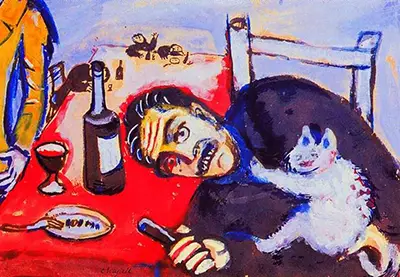This work seems almost cartoon-like in style, with a middle aged man leaning over his kitchen table, with a cat clinging onto his torso. Elements of the table are included, such as a bottle of red wine, some of which has been poured into a glass by its side. There is also some other kitchenware as well as a bright red tablecloth. An arm from another figure randomly juts in from the left hand side of the painting and a chair is included with minimal detail. This feels distinctly like an artist who is attracted to contemporary styles of work, but is still finding his way. Indeed, Man at Table has relatively little information available about it online, either in English or French, suggesting that it is not considered one of the highlights of his career, although it still can help us learn more about the artist's career.
The artist would have been in his mid-twenties by the time that he worked on this artwork and clearly he was still very much in the process of finding and developing his own artistic style at this stage. Whilst clearly being in a contemporary style, there are none of the dreamlike qualities that became his signature approach, as shown in the likes of I and the Village, La Mariee and Birthday. It makes items such as Man at Table all the more interesting in that regard, as we can learn much more about how he changed over time. In recent years there has been a growing interest in understanding the full scope of his oeuvre, rather than just the most famous paintings from his career.
We have featured around one hundred paintings, drawings and stained glass window designs within this website and have attempted to cover his career in a comprehensive manner, making additions such as this one particularly important. Many of his less known artworks are now within private collections and so sadly it is harder to access them and also to learn more about them, as generally it is only when items are at major art institutions is there any effort to further research and document them, as well as perhaps employing scientific techniques in order to learn even more. In some cases, though, these pieces may be sold on again and then potentially be snapped up by such institutions in the future, with lesser known pieces being potentially more affordable.

